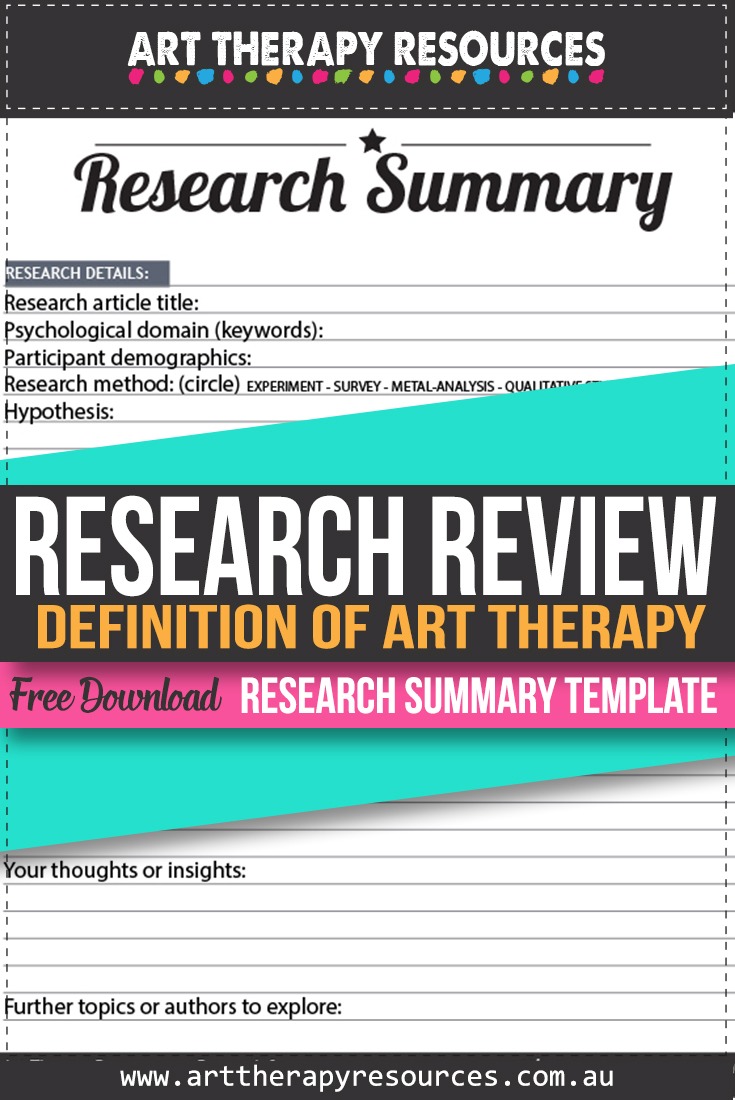THIS POST INCLUDES:
1. Article purpose
2. Article Proposal
3. Further reading
4. Free Download Research Summary Template
ARTICLE PURPOSE
ABSTRACT
Quoted from original article:
“In this viewpoint the author makes a case for developing a clear and concise definition of art therapy that can easily be adopted by art therapists working across a spectrum of theoretical frameworks. The reader is asked to widen the lens through which art therapy is defined by considering its influence on society, the mind, health, and behavior. Reenvisioning art therapy in this way could promote its mission with individuals, organizations, and communities. Rather than suggesting a specific definition, it is hoped that this viewpoint will inspire new ideas for those who actively seek to more accurately define the field.”
ARTICLE PROPOSAL
CULTIVATE PARTNERSHIPS
POSITION ART THERAPISTS AS LEADERS
CREATE A UNIFIED DEFINITION
OTHER PROPOSALS
- Encourage graduate art therapy programs to customise curricula
- Focus on creating a distinct identity and professional credentials
FURTHER READING
- American Art Therapy Association. (2007). Masters education standards.
- American Art Therapy Association. (2013). What is art therapy?
- Betts, D. (2016). National recognition for art therapy through AATA’s partnership with Americans for the Arts.
- Kapitan, L., Litell, M., & Torres, A. (2011). Creative art therapy in a community’s participatory research and social transformation. Art Therapy: Journal of the American Art Therapy Association, 28(2), 64–73. doi:10.1080/07421656.2011.578238
- Kramer, E., Drachnik, C., Anderson, F., Landgarten, H., Levick, M., & Riley, S. (1994). How will art therapy change in the next 25 years? Responses by past award winners. Art Therapy: Journal of the American Art Therapy Association, 11(2), 91–101. doi:10.1080/07421656.1994.10759057
- Lambert, P.D., Rollins, J., Sonke, J., & Cohen,R. (2016). Introducing the arts in healthcare field. In P. D. Lambert (Eds.), Managing arts programs in healthcare.New York,NY: Taylor&Francis.
- McNiff (2013). Developing arts and health: Within creative-arts therapy or separately? Journal of Applied Arts & Health, 4(3), 345–353. doi:10.1386/jaah.4.3.345_1
- National Endowment for the Arts. (2015, November 12). Creative arts therapy a useful tool for military patients [News post].
- Peacock, K. (2012). Museum education and art therapy: Exploring an innovative partnership. Art Therapy: Journal of the American Art Therapy Association, 29(3), 133–137. doi:10.1080/07421656.2012.701604
- Towne, T. (2016). Looking forward—Thoughts on the future of art therapy—A personal perspective. In D. Gussak, & M. Rosal (Eds.), The Wiley handbook of art therapy [Kindle version]. Retrieved from Amazon.com
FREE DOWNLOAD: Research Summary Template

BUILD YOUR ART THERAPY REFERENCE MATERIALS:
Pin this image to your Pinterest board.

SHARE KNOWLEDGE & PASS IT ON:
If you’ve enjoyed this post, please share it on Facebook, Twitter, Pinterest. Thank you!
